Maxxis Assegai
Stated Dimensions: 29” x 2.5”
Blister’s Measured Width (on 30 mm internal rim @ 23psi):
- Tread width: 64.2 mm (2.52 in)
- Casing width: 59.3 mm (2.33 in)
Casing tested: Exo+
Rubber Compound tested: 3C MaxxTerra
Stated Weight: 1125 grams
Blister’s Measured Weight: 1157 grams
Mounted to: Yeti SB5.5 / DT Swiss XM481 rims
Intended Use: All-Conditions; Trail & DH
MSRP: $80.00
Reviewer: 5’10”, 180 lbs
Test Location: Front Range, CO
Duration of Test: 250+ miles
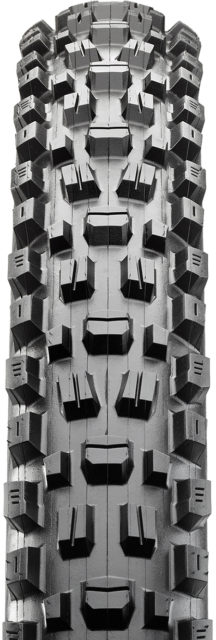
Intro
If you stand around any trailhead and pay attention to the rubber hitting the trail, you will quickly realize that in the current mountain bike tire world, there is Maxxis and there is everyone else. This isn’t due to a lack of quality options among other brands; rather, I would argue that Maxxis’ brand popularity is due largely to a tire we all know and appreciate, the Maxxis Minion DHF. In a recent episode of our Bikes and Big Ideas podcast, Noah Bodman and David Golay both went so far as to include the DHF in their list of the most influential components from 2000-2009. Yet it’s 2020 and the DHF is still one of the most common mountain bike tires anywhere.
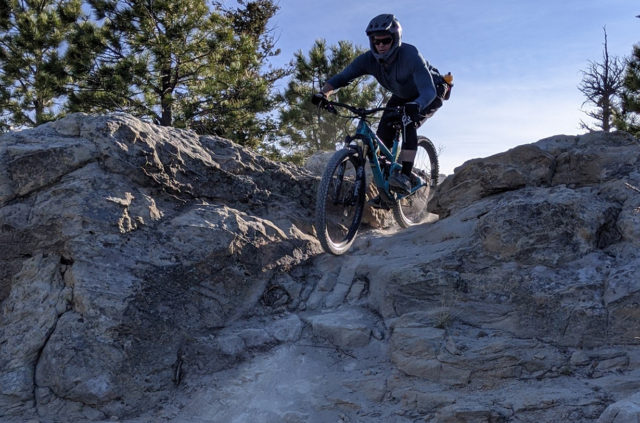
But even with the success of the DHF as an aggressive tire with significant grip, in April 2018, Maxxis announced that they had been working with downhill rider Greg Minnaar on a signature tire. Minnaar says he attempted to combine elements of other Maxxis tires he liked — the DHF, DHR II, Shorty, and High Roller — into a versatile, supportive, and grippy tire. The result is the Maxxis Assegai (pronounced “assy guy”). The pronunciation belies what the Assegai actually is: a traditional Zulu warrior spear from the KawZulu Natal region of Minnaar’s native South Africa. For me at least, the name immediately goes from humorous to badass upon reading that factoid. Of course, that factoid still might not prevent your friends from asking “what kind of guy you are” if you’re riding this tire…
So, does this world-champion-designed tire with a totally unfunny name deserve your attention? Here’s my take:
Design, Options, & Measurements
Measuring the Assegai and a DHF of the same size, compound, and casing revealed more similarities than differences. As is usually the case with bike tires, the Assegai weighs more than what Maxxis publishes, weighing 1157 grams compared to a stated weight of 1125 grams. When looking at the stated weight of a DHF with the same casing and compound, the Assegai is reportedly 50 grams heavier. The casing of both tires measure to within tenths of a millimeter of one another, 59.3 mm for the Assegai versus 59.6 mm for the DHF. As expected, the slightly larger side knobs of the DHF cause it to be wider (knob to knob) at 65.5 mm (2.57 in) against 64.2 mm (2.52 in) for the Assegai.
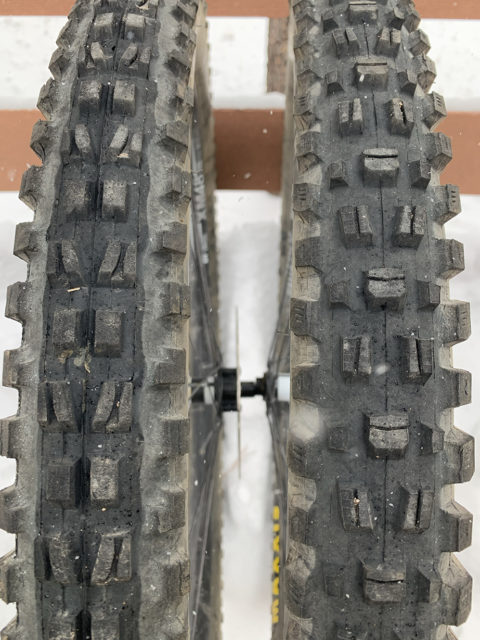
TLDR: the Assegai is quite close to the DHF in weight and overall size with the Assegai being slightly heavier and very slightly smaller knob-to-knob vs. the DHF. In terms of the actual tread, the biggest differences come down to the Assegai’s intermediate knobs, and it’s slightly smaller side knobs. Additionally, a side-by-side look at the tread pattern indicates that the Assegai has more widely spaced center knobs than does the DHF. As I’ll get into below, the Assegai’s additional intermediate knobs and more widely spaced centerline knobs make for the most notable difference on trail, in my opinion.
I’d like to point out that these tires both measure at or slightly larger than their stated width (something that wasn’t true with some past Maxxis tires). Having a tire measure at its stated width isn’t necessarily a triumph of modern technology, but it’s nice that, on a 30mm rim, a “2.5-inch” tire measures 2.5 inches. It’s also worth noting that the “WT” (Wide Trail) designation on the Assegai means that their casing is optimized for rims with 30-35 mm of internal width. Maxxis says that traditionally constructed tires can become overly square in profile when used on wider rims and optimizing the tire’s construction for wider rims makes the tire perform better. I’ve been on a few tires on modern wider rims where I did notice that the square-ish profile seemed to engage all the knobs at once in some situations. — not ideal. The Assegai has had no such issues.
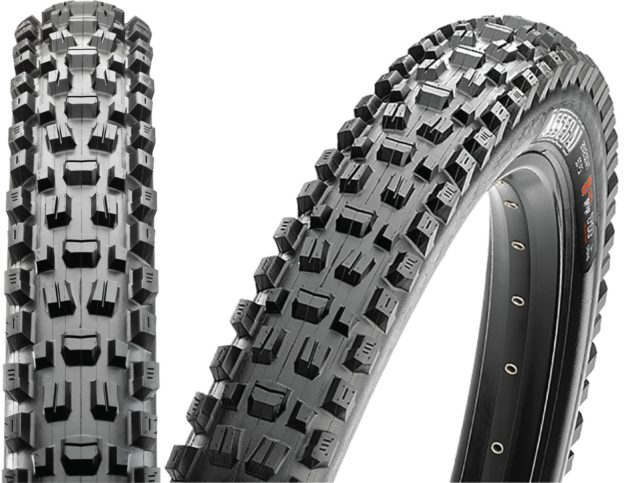
The Assegai I reviewed came in the Exo+ casing with the 3C MaxxTerra compound. Exo+ is Maxxis’ mid-weight casing with added sidewall protection vs. the lighter Exo casing. The “+” comes from an added layer of their SilkShield protective membrane running from bead to bead over the non-plus Exo casing. The 3C MaxxTerra compound I’ve been testing uses three different compounds, varying in softness, throughout different areas of the tread depending on where grip or durability is most important. Both the Exo+ casing construction and the 3C MaxxTerra compound sit in the middle of Maxxis’ offerings. Maxxis does offer other casings for the Assegai: the lighter, non-SilkShield Exo, as well the much heavier and more protective DoubleDown and DH casings. Additionally, the Assegai is available in the longer-wearing Dual compound and the softer and grippier MaxxGrip compound. For this review, I only rode the Exo+, 3C MaxxTerra version.
The DHF “Drift”
Let me get one thing out of the way upfront. Like our other esteemed reviewers, I too am a fan of the Minion DHF. It has been the front tire (and sparingly, a rear — more on that later) of choice for my riding for some time.
But for my style, there was always something missing. At moderate lean angles, I found that the DHF had a tendency to feel vague before the large side knobs fully engaged. For aggressive riders with solid cornering technique, that quality might be desirable (for more on that, check out our Tires 101 article). For me personally, however, a lot of my daily rides occur on the decomposing “kitty litter” conditions that tend to be prevalent here on the Front Range of Colorado. Having predictable grip from centerline all the way through to the side knobs without any drift initiation at moderate lean angles is important for me and where I ride.
In theory, a tire with intermediate knobs would offer grip where the empty intermediate channel of the DHF (or many other tires without intermediate knobs) did not. This is the reason the Assegai caught my attention. Having experienced some loss of grip at moderate lean angles in the past (aka, biffing mid-corner as ride buddies laughed like hyenas), I was eager to see if the tread pattern of Assegai could help a moderate rider become more confident.
[Side note: If you want to learn more about some of the terms used in this review, as well as the specific tendencies of tires with intermediate knobs like the Assegai, check out our Mountain Bike Tires 101 article.]
Installation
The fellas at my local bike shop did the initial installation, though I have since removed and remounted the Assegai twice. I could remove and remount it with my hands, but my meager floor pump didn’t have the juice to seat the tire either time. In my experience, regardless of how easy or hard it is to get the tire on the rim, large, tubeless mountain bike tires require the pressure of an air compressor or a booster-style floor pump. That said, my guess is that if you tend to nail tire installs with nothing but your trusty pump, this isn’t one of those tires that will get a reputation for difficult installations.
Ride Impressions
Rolling onto the trail, I can’t say that there was any immediate revelation or eureka moment when I switched from a DHF to the Assegai. But over the course of many rides, I really started to enjoy the subtle differences between the Assegai and the DHF. I’m also deliberately using “differences” instead of “improvements” here because your opinion on whether or not one of these tires is “better” or “worse” than the other will depend on the qualities you look for in a tire.
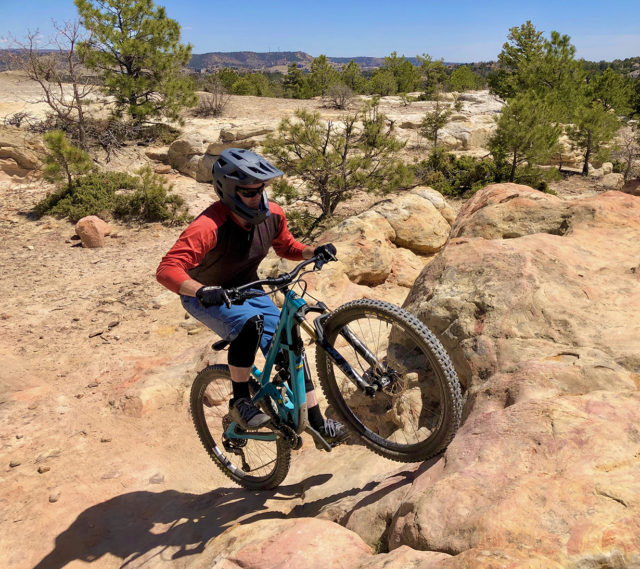
So, what are some of those differences? In a word, grip. Lots of grip. Both when you want it, and potentially, when you don’t. At those aforementioned moderate lean angles where I used to notice a vagueness in the DHF, I noticed a more predictable transition to the side knobs on the Assegai. In short, off-camber, and / or loose corners where you never really get the bike all the way into a deep lean, the front of the bike remained predictable and in control with the Assegai.
In corners where, in the past, I would too-quickly lean the bike in an effort to get to the DHF’s side knobs before any loss of grip, I found myself more casually arcing the Assegai into corners without any apprehension over the “drift” between the center and side knobs. For a rider like me who enjoys cornering only as a means to get to the next straight section to smash, the Assegai made cornering easier. Simple as that.
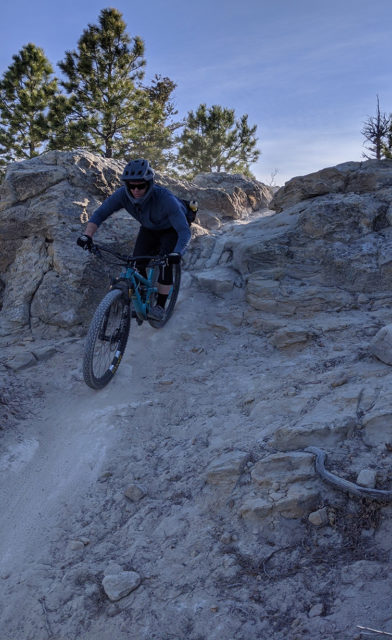
In the past, Noah Bodman has written about how intermediate knobs can reduce the effectiveness of the side knobs during hard cornering, essentially making it harder to access and fully utilize those side knobs. I have to say that, while I agree on the physics of how one block of rubber at the intermediate position could make it harder to compress the outermost knobs, I didn’t personally notice a huge difference in grip when leaning the bike way over on a DHF vs. Assegai. Depending on your own cornering technique, you may experience this difference. For me though, the Assegai just seems to have loads of mechanical grip from centerline all the way to a deep lean.
One of the other things I’ve liked about the Assegai is its ability to shed wet dirt and mud. Now, I would never accuse the Assegai of being a mud spike and much of my time on it has been on fairly dry trails. But for an all-conditions tire that really bites on loose-over-hard trails, when it did encounter some damp loam or even soaked dirt, the widely spaced knobs rather quickly shed anything that stuck to the tire. On a damp ride in the famous Enchanted Forest near Golden, CO (one of the few places on the Front Range to get nice, shaded dirt), I was surprised by how easily the tire let go of the gunk on several muddy creek crossings.
[Editor’s Note from David Golay: I’ve had many more opportunities than Ben to ride the Assegai in much, much wetter conditions, and it does fine for a general-purpose, versatile tire. As he said, it’s certainly not a mud spike, and doesn’t truly excel in these conditions, but it’s adequate. The two things I’d highlight are that (1) in really good, slightly damp hero dirt, the reduced ability to really dig the corner knobs in compared to something like the DHF is at its most apparent and (2) the Assegai is a bit squirmy on wet roots. For a versatile, all-rounder sort of tire, the Assegai is not bad in the wet, but it’s not the first thing I’d recommend if you’re predominantly riding in fairly damp conditions.]
So with all that said, where does the Assegai grip where it shouldn’t? In the form of rolling resistance.
The wider-spaced center knobs (vs. the DHF) did cause a noticeable difference in rolling resistance, particularly on hardpack or rock. To be fair though, it takes a relatively smooth surface for me to notice the resistance that a tread pattern causes on a front tire. This brings me to what I think is a critical aspect of the Assegai’s design and how it compares to the DHF.
Assegai as a Rear Tire
Maxxis — as well as other brands — make a number of terrific rear-specific tires. Based on its knob pattern and qualities as a front tire, I was apprehensive about using the Assegai as a rear tire. You could definitely use the Assegai as a rear tire. In fact, a handful of bikes are coming stock with the Assegai on the front and rear, though I think the reason for this is more related to economies of scale and simplicity for factory assembly. But the point remains, there are people riding this tire as a rear tire and still having a good time.
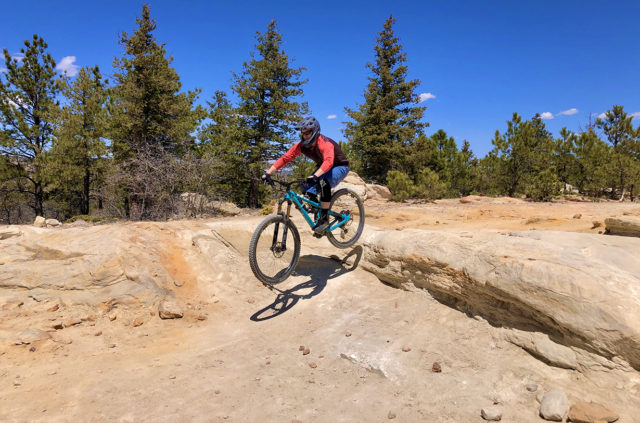
I have ridden the DHF as a rear tire on occasion and found it to be serviceable, but I’d argue that there are several better options within the Maxxis lineup, depending on your priorities. The Aggressor is a far faster-rolling tire than the DHF, and the DHR II is a much stronger braking one. If anything, the Assegai rolls a touch slower than the DHF, but doesn’t match the DHR II on braking, so it doesn’t strike me as a particularly strong contender for use as a rear tire.
Mind you, I wouldn’t refuse to ride a bike that had the Assegai mounted in the rear. But I would look to replace it with any of the excellent rear-specific tire choices on the market when the Assegai’s useful life was up.
Durability
After more than 250 miles of riding on mostly dry, rocky, rough trails, I’ve had zero punctures, zero sidewall cuts, & zero torn-off knobs (the comparison photo above shows the Assegai reviewed here after those 250+ miles).
Between the Assegai reviewed here and various other Maxxis tires, I’ve had a lot of experience with the Exo+ casing + 3C MaxxTerra compound that Maxxis offers. Knock on wood, they’ve all been extremely durable and robust. For aggressive trail riding with the very occasional gravity race thrown in, the lighter Exo+ and longer-lasting 3C MaxxTerra combination has served me well vs. the Double Down casing or DH casings. For those of you who don’t mind a bit more weight and your rubber wearing down a bit quicker, the super tough / super sticky DoubleDown + 3C MaxxGrip option is also available for a weight penalty of approximately 180 grams and another 30 grams gets you the full DH casing. I really don’t have much to complain about in this section.
Who’s It For?
If you’ve ridden a Minion DHF, like its versatile grip, but found yourself longing for a more consistent transition from the center knobs to the side knobs while cornering, the Assegai is worth considering — especially as a front tire, and particularly if you’re not looking to use it predominantly in very wet conditions.
The Assegai doesn’t offer quite as solid of a bite with the side knobs fully engaged as the DHF, but the Assegai also doesn’t require the same commitment to leaning the bike over through the open channel between the center and side knobs to get there. This can make for more accessible grip if you’re not someone who’s always committed to really leaning your bike over through every turn.
Bottom Line
For many riders, having predictable grip at the range of lean angles is of supreme importance. With the Assegai, Maxxis accomplished this by combining solid attributes from other tires and introduced a tire that doesn’t compete with the DHF so much as augment the lineup to provide riders with yet another solid option for aggressive riding.

This tire seems similar to Specialized Eliminator, knobby meaty tire with transition knobs for people who don’t have God given talent and don’t shred trails like the top 1%.
I’m quite happy with the Eliminator, got that and Slaughter (Minion SS) for the rear in 2.3″ variant and it is wonderful, fast and fun combo that grips great in turns and rear tire has much better braking and climbing traction than you’d think looking as it.
I’ve got much better durability and puncture protection on Specialized GRID casing over Maxxis EXO and Specialized tires are wider and at 2.3″ they’re about the size of Maxxis 2.4″ WT on 30mm rims.
Replying to Marin.
I agree, the tread pattern on the Specialized Eliminator does look similar to the Assegai reviewed above. A number of brands have released tread patterns that have intermediate knobs for the reasons we outlined in the review and in your comment.
I am much less familiar with Specialized’s casing and compound options. As always, casing durability is as much a function of riding style, tire pressure, and where you ride as the casing itself. And seems Specialized has done a similar thing to Maxxis in that they inserted a slightly beefed up casing over the the standard GRID called the GRID TRAIL. Cheers.
Maxxis has great tires for a few rides.
Then they’re worn out. Specifically the side knobs are unsupported, bendy and grippy is great in soft loam, in loose over hard they work too but get torn easily.
Where I live I need support for the side knobs. WTB, Kenda even Goodyear have able options. But lately I’ve been all about Vittoria Martello.
Hot soapy water, I kid you not, seats the Assegai to a 30mm rim without much effort.
I thought the comment on tubeless seating was strange as I have put several Dh cased assegai on with just a cheap floor pump. Only trick used, (if you can even call it that) was to remove the valve core.